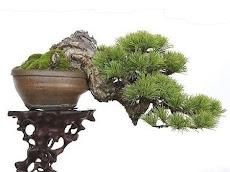
by: Patrick Desnoyers
One of the popular broadleaf species for bonsai is the cotoneaster. This specie is praised for it’s small leaves, fruits and ramification which makes it a mame candidate. These preferred characteristics can also be accentuated by choosing a species of cotoneaster.
The cotoneaster multi-florus is by it’s name liked for having many flowers, from white to pink, but it is producing larger leaves then other cotoneaster.
The cotoneaster microphyllus, by it’s common name small leave cotoneaster, this one shows incredibly small leaves, which makes it the perfect tree for really small bonsai.
The most preferred bonsai candidate of cotoneaster is the cotoneaster horizontalis or commonly called rockspray cotoneaster. In all proportion this is the best choice, because it is a fast grower, small leaves, produce flowers early, and bear fruits at a young age.
Aesthetically, this one is a show stopper. In spring it displays wonderful colors with a mix of light and dark green for the foliage, white, pink and red for the flowers. As the growing season progress, leaves turn from a light green to a dark glossy green. In the meantime, the tree is preparing itself to support bright red fruit. In the colder climate, the cotoneaster loose it’s leaves but keep it’s fruit till early winter. The denuded tree with bright red fruit and white snow makes it a good subject for picture.
Cotoneaster can be propagated in many ways. The more common are by cuttings or by seeds. Growing a cotoneaster bonsai from seeds is easy compare to other species, because it is a fast growing tree and it’s ramifying itself at an early age. I prefer to grow from seeds rather then cuttings, because in a growing season, a sprouted seeds can attain the same girth as a cutting.
Germinating a cotoneaster seeds can be tricky. Fortunately, the most common used cotoneaster as bonsai, are producing seeds that necessitate boiling water to scarify the seeds, before germination, compare to some cotoneaster species that requires an acidic treatment to remove the protective coating. In nature, this treatment is accomplished in the stomach of the fruit eating animal that ingested a cotoneaster berrie.
About The Author
Patrick Desnoyers
Avid full time hobby bonsai grower. As been practicing bonsai and gardening for more then 8 years. Owner of http://www.mishobonsai.com , a website with ressource for bonsai seeds and tree seeds.





